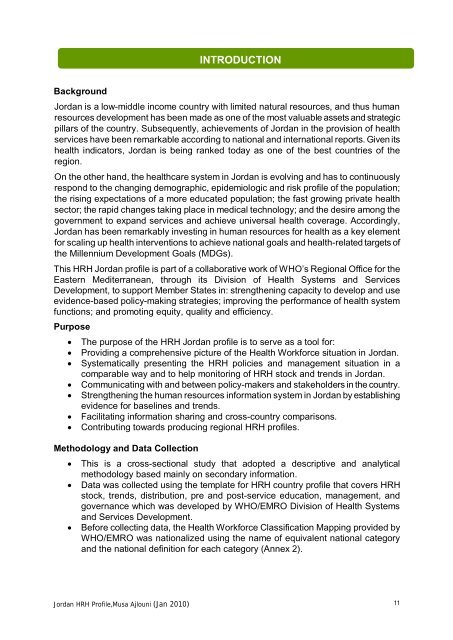Prepared by: Dr. Musa Ajlouni January, 2010 - World Health ...
Prepared by: Dr. Musa Ajlouni January, 2010 - World Health ...
Prepared by: Dr. Musa Ajlouni January, 2010 - World Health ...
You also want an ePaper? Increase the reach of your titles
YUMPU automatically turns print PDFs into web optimized ePapers that Google loves.
INTRODUCTIONBackgroundJordan is a low-middle income country with limited natural resources, and thus humanresources development has been made as one of the most valuable assets and strategicpillars of the country. Subsequently, achievements of Jordan in the provision of healthservices have been remarkable according to national and international reports. Given itshealth indicators, Jordan is being ranked today as one of the best countries of theregion.On the other hand, the healthcare system in Jordan is evolving and has to continuouslyrespond to the changing demographic, epidemiologic and risk profile of the population;the rising expectations of a more educated population; the fast growing private healthsector; the rapid changes taking place in medical technology; and the desire among thegovernment to expand services and achieve universal health coverage. Accordingly,Jordan has been remarkably investing in human resources for health as a key elementfor scaling up health interventions to achieve national goals and health-related targets ofthe Millennium Development Goals (MDGs).This HRH Jordan profile is part of a collaborative work of WHO’s Regional Office for theEastern Mediterranean, through its Division of <strong>Health</strong> Systems and ServicesDevelopment, to support Member States in: strengthening capacity to develop and useevidence-based policy-making strategies; improving the performance of health systemfunctions; and promoting equity, quality and efficiency.Purpose· The purpose of the HRH Jordan profile is to serve as a tool for:· Providing a comprehensive picture of the <strong>Health</strong> Workforce situation in Jordan.· Systematically presenting the HRH policies and management situation in acomparable way and to help monitoring of HRH stock and trends in Jordan.· Communicating with and between policy-makers and stakeholders in the country.· Strengthening the human resources information system in Jordan <strong>by</strong> establishingevidence for baselines and trends.· Facilitating information sharing and cross-country comparisons.· Contributing towards producing regional HRH profiles.Methodology and Data Collection· This is a cross-sectional study that adopted a descriptive and analyticalmethodology based mainly on secondary information.· Data was collected using the template for HRH country profile that covers HRHstock, trends, distribution, pre and post-service education, management, andgovernance which was developed <strong>by</strong> WHO/EMRO Division of <strong>Health</strong> Systemsand Services Development.· Before collecting data, the <strong>Health</strong> Workforce Classification Mapping provided <strong>by</strong>WHO/EMRO was nationalized using the name of equivalent national categoryand the national definition for each category (Annex 2).Jordan HRH Profile,<strong>Musa</strong> <strong>Ajlouni</strong> (Jan <strong>2010</strong>) 11

















